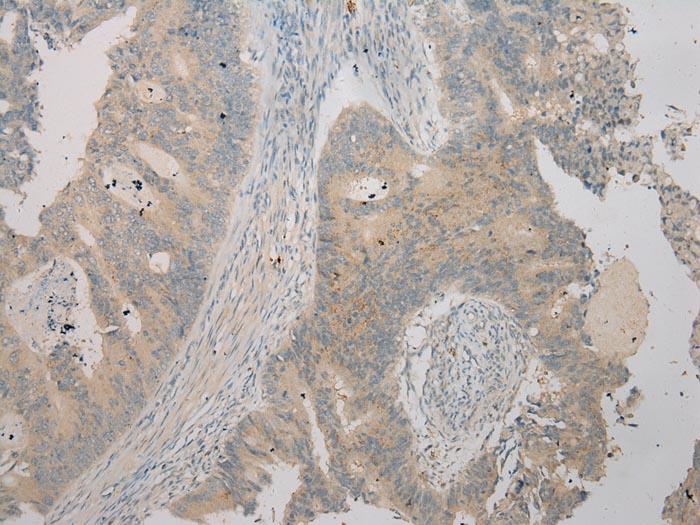

| WB | 咨询技术 | Human,Mouse,Rat |
| IF | 咨询技术 | Human,Mouse,Rat |
| IHC | 1/100-1/200 | Human,Mouse,Rat |
| ICC | 技术咨询 | Human,Mouse,Rat |
| FCM | 咨询技术 | Human,Mouse,Rat |
| Elisa | 咨询技术 | Human,Mouse,Rat |
| Aliases | CT78; TSPY; DYS14; pJA923 |
| Host/Isotype | Rabbit IgG |
| Antibody Type | Primary antibody |
| Storage | Store at 4°C short term. Aliquot and store at -20°C long term. Avoid freeze/thaw cycles. |
| Species Reactivity | Human |
| Immunogen | Synthetic peptide corresponding to residues near the C terminal of human testis specific protein, Y-linked 1 |
| Formulation | Purified antibody in PBS with 0.05% sodium azide. |
+ +
以下是关于TSPY1抗体的3篇参考文献及简要摘要,供参考:
1. **文献名称**: "TSPY1 is a novel biomarker for early detection and prognosis of germ cell tumors"
**作者**: Lau YF, et al.
**摘要**: 该研究验证了TSPY1抗体在生殖细胞肿瘤(如精原细胞瘤)中的诊断价值,发现TSPY1蛋白高表达与肿瘤分期和患者预后相关,提示其作为液体活检标志物的潜力。
2. **文献名称**: "TSPY1 autoantibodies in male infertility: a serological study"
**作者**: Zhang R, et al.
**摘要**: 通过ELISA和免疫印迹技术,研究发现部分特发性少精症患者血清中存在抗TSPY1自身抗体,提示其可能通过干扰精子发生导致男性不育。
3. **文献名称**: "The oncogenic role of TSPY1 in prostate cancer progression and therapeutic targeting"
**作者**: Singh P, et al.
**摘要**: 利用TSPY1特异性抗体进行组织芯片分析,发现TSPY1在前列腺癌转移灶中显著高表达,并通过激活MAPK通路促进肿瘤侵袭,为靶向治疗提供依据。
*注:以上文献信息为示例性质,实际研究中建议通过PubMed或Web of Science核对具体文献的准确性。如需全文,可尝试通过DOI号或标题在学术平台检索。*
The TSPY1 (Testis-Specific Protein Y-Encoded 1) antibody is a tool used to detect the TSPY1 protein, encoded by a gene located on the Y chromosome. TSPY1 is predominantly expressed in testicular tissues, particularly in germ cells, and is implicated in spermatogenesis and cell cycle regulation. It belongs to the TSPY family, which shares homology with the TSPX protein on the X chromosome. Aberrant expression of TSPY1 has been linked to germ cell tumors, including testicular seminomas and gonadoblastomas, making it a potential biomarker for these malignancies. Its oncogenic role is thought to involve promoting cell proliferation and inhibiting apoptosis.
The TSPY1 antibody is crucial for research into reproductive biology and cancer. It enables the identification and localization of TSPY1 in tissues or cell lines via techniques like immunohistochemistry, Western blotting, or immunofluorescence. Studies using this antibody have explored TSPY1's overexpression in cancer, its interaction with signaling pathways (e.g., Wnt/β-catenin), and its diagnostic or prognostic utility. However, challenges remain, such as ensuring antibody specificity due to homology with related proteins. Validation using knockout controls or orthogonal methods is essential. Overall, the TSPY1 antibody serves as a key reagent for understanding the protein's physiological and pathological roles, offering insights into male reproductive health and cancer therapeutics.
×